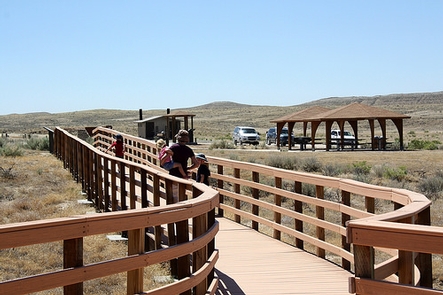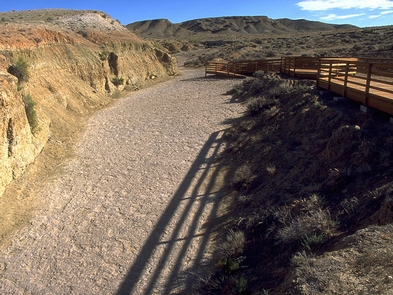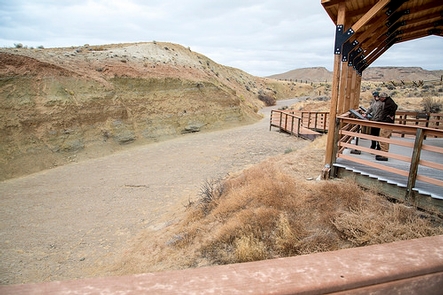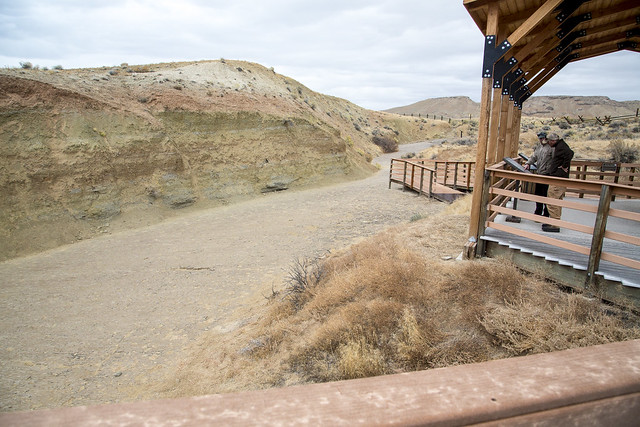Red Gulch Dinosaur Tracksite
At BLM's Red Gulch Dinosaur Tracksite, you can imagine walking along an ocean shoreline 167 million years ago with dozens of dinosaurs, who were looking to pick up a bite of lunch from what washed up on the last high tide. The sandy ground is soft and your feet sink down in the thick ooze, leaving a clear footprint with every step you take.
The Red Gulch Dinosaur Tracksite is the largest tracksite in Wyoming and one of only a few worldwide from the Middle Jurassic Period (160 million to 180 million years old). Until the tracks were reported in 1997, most scientists thought the entire Bighorn Basin and most of Wyoming was covered by an ancient ocean called the Sundance Sea.
Not only are there hundreds of tracks at the site, but the 40-acre area could contain thousands more. The dinosaur tracks were clearly made just at the shoreline, not in deep ocean water, and there must have been large areas of dry land to support not only dinosaurs but other animals and plants.
The limy mud that the dinosaurs were walking in probably felt similar to cement just starting to harden. The tracks were perfectly preserved when the mud hardened and was covered by more layers of ooze, and then by fine sand, filling the tracks and preserving their shape. Over the years, layer upon layer of sediment filled in over the top. Much later, erosion went to work and removed those layers, exposing the tracks that had been made all those millions of years ago.
The tracks were reported in 1997 by Greybull native Erik Kvale while he was enjoying the scenery with Allen Archer, Rowena Manuel, Cliff Manuel and Fran Paton on BLM-administered lands. Their discovery altered the views about the Sundance Formation and the paleoenvironment of the Middle Jurassic Period in North America.
In 2002, the site was renovated with a new boardwalk, interpretive signs, picnic tables, benches, trails, an upgraded access road and graveled parking for up to 15 cars and three buses.
Photos
Accessibility Description (ABA/ADA)
View images of accessibility features in a new window.
Parking for the site is in a large packed-dirt and gravel lot, with 1 paved accessible parking space. The spot has an access aisle and is signed and painted. There is an accessible unisex double vault toilet next to the parking area. Cell phone reception at the site is spotty, and there is no potable water available.
A 4-foot concrete path leads first to an information kiosk with interpretive panels and then to 2 picnic shelters, each including at least 1 accessible table with an extended end to accommodate wheelchair users. The shelters sit on concrete pads with no lip between the path and the pads. There is a 2-in-1 pedestal grill not designed with accessibility in mind.
The concrete path also leads to a boardwalk of the same width that runs parallel to the tracksite and fossil wall. The boardwalk is made of well-maintained composite decking with a shallow grade and handrails for its entire length. There is no lip between the concrete path and boardwalk. Interpretive signs in an open area along the boardwalk sit at a height and angle appropriate for people using mobility devices. There are no benches in this area.
At the end of the boardwalk is a shaded overlook of the tracksite. This covered pavilion features a bench with no arms, interpretive signs, and stationary sighting tubes at different heights to viewpoints of interest. A short ramp with a grade of less than 5 percent leads from the pavilion to the tracksite. A metal connector from the ramp to the tracksite provides a smooth transition for wheelchair users.
The tracksite has a hard, compacted natural surface that can accommodate wheelchairs and other mobility devices. Near the tracksite is an area where loose invertebrate fossils can sometimes be spotted.
The distance from the parking lot to the tracksite is 740 feet.
Descriptions and photos uploaded January 2025. Please note that actual on-the-ground conditions may vary due to natural events (e.g., weather, wildfires, erosion), normal wear and tear, or site improvements.
Red Gulch Dinosaur Tracksite Photos
Red Gulch Q&As
BLM Wyoming Know Before You Go
Paleontology in the Bighorn Basin
Red Gulch Science & Discovery
Phone
Activities
Addresses
Geographic Coordinates
Directions
Travel approximately eight miles east of Greybull WY (or four miles west of Shell) on US Highway 14 to the Red Gulch/Alkali National Back Country Byway turnoff. Head south on the Byway approximately five miles.








